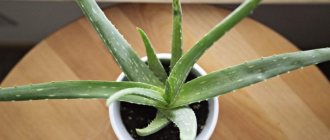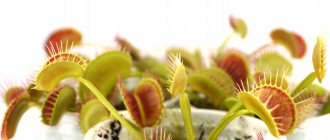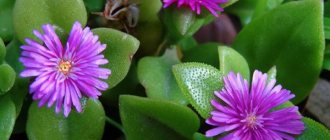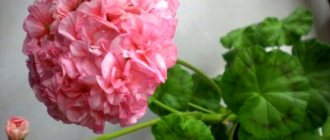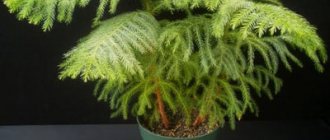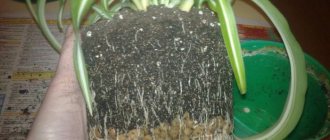Photo of milkweed Euphorbia mile (M. milius, M. brilliant, M. mile, M. mili) is a highly branched succulent, a perennial shrub from the Euphorbiaceae family . Under natural conditions it grows in the arid regions of Madagascar and Mexico. In Europe it is grown indoors. The plant is named after Governor Fr. Reunion of Baron Pierre Bernard Milius, who brought him to France.
Euphorbia milia in nature grows up to 2 m; at home, its height rarely exceeds 1.5 m. The shrub grows slowly. Oval leaves are formed at the tops of the thorny shoots, which fall off in the fall. Small flowers on long green peduncles are located outside the spines. Small bright bracts attract attention.
| The shrub grows slowly. |
| Homemade milkweed milia blooms almost all year round and always looks elegant. |
| The plant is easy to grow. |
| Perennial. |
What does Euphorbia Mila look like, what family does it belong to?
Euphorbia milius species is a succulent. In its homeland, under natural conditions, it reaches large sizes with abundant branching. The stem has a gray tint, slightly silvery. At the top of each shoot, light green leaves about 3.5 cm long are formed. Each leaf blade has several stipules that turn into sharp spines. The leaves fall off over time, but the spines remain on the plant. For this reason, leaves are formed only at the top of the shoots.
Euphorbia Mila in bloom in different shades
The bracts are painted in bright colors - yellow, orange, red. These plates are 12mm wide and round in shape. The inflorescences form several groups of flowers, which are surrounded by bright bracts. The inflorescences are bizarre, they are woven together with spines on long stalks.
Common varieties
There are main varieties that have different colors of inflorescences. Among them:
- Sakura kiss – white flowers with pink splashes;
- King yellow – solid yellow inflorescences;
- Moonlight – yellow flowers with an orange center;
- Natali – pink inflorescences, periodically there are dark stripes;
- Sonora – characterized by bright pink bracts.
Medicinal properties
The sap of the plant is poisonous. The composition of this liquid includes rubber, quamarines, resins, malic acid and euphorbion.
Important! In small doses, this composition has a beneficial effect on the human body.
Large milkweed needles
The juice is used to treat abrasions and wounds, as it has a healing and disinfecting effect. Before use, you need to carefully evaluate the likely benefits and harms of using this plant.
Briefly about the history of appearance
The governor of Reunion Island brought Mila to France back in 1821. The plant came to Europe from Madagascar and Africa. By nature it is a mountain flower.
Varieties
Today there are many varieties of euphorbia known, each of which is characterized by certain characteristics.
White-veined or white-veined
This plant has dark green foliage. Young bushes have white veins, but after some time they lose this shade. Over time, leaves appear only at the top.
mile
This is a large bush with thorns. The ends of the shoots are decorated with small leaves, and small flowers form red or yellow inflorescences.
Triangular or triangular
This is a stem succulent that has triangular stems. The plant is characterized by red-brown thorns. The culture can reach 2 meters.
Bordered
This plant is characterized by straight stems measuring 80 centimeters. They are covered with oval leaves of a light shade.
Tirukalli
This is an unusual plant that has many leafless shoots. The leaves of the crop fall off without having time to grow. Flowering is observed very rarely.
Comb
This is an evergreen shrub that has a thick stem. It is decorated with oval leaves measuring 20 centimeters. The flowers are white or pink.
Brilliant
This plant is characterized by the presence of spines and small leaves. The flowers are small in size and have richly colored flowers.
Beautiful
Poinsettia is considered a spectacular type of milkweed. The bush reaches 40-50 centimeters and has straight stems and large leaves. The bracts are large in size and can have a white, red or pink tint.
Head of Medusa
The plant is characterized by thickening in the upper part of the stem and branches, which diverge in different directions. The culture looks very unusual.
Fat
This is a small cylindrical plant that has tubercles. The green trunk is covered with stripes and has no thorns.
Enopla
In appearance, the culture resembles a cactus and is 30-100 centimeters in height. The shoots are distinguished by their cylindrical shape and rich green color.
Features of plant care at home
Euphorbia can be grown as a standalone plant or in containers with other succulents. Some rules of care will help you grow a beautiful and healthy flower. Caring for a succulent is quite simple.
Temperature
Christmas star flower - how to care at home
Euphorbia Mila is a heat-loving plant. In summer, the optimal temperature is +25 ℃. In winter, you need to make sure that the thermometer needle does not fall below +15 ℃. Cold affects the bush negatively; hypothermia should not be allowed.
Lighting
Euphorbia requires intense lighting, which it will need year-round. In winter, you need to use an artificial light lamp. It is better to place a pot with a plant on southern windows. In the summer, if there is open ground, a container of milkweed is buried in the garden.
Watering
Watering must be dosed carefully. Moisturizing is done only in summer; in winter, watering is removed altogether. Despite its high resistance to drought, milkweed requires moist soil for normal development.
Important! It is better to use soft water for irrigation. When the soil dries out, the plant immediately sheds its leaves, but this will not lead to death.
Spraying
Spray the flower often, in between waterings. Additionally, you can wash the plant, but this must be done very carefully.
Propagation of milkweed by cuttings
Humidity
Euphorbia has no special conditions for humidity. The shrub tolerates drought normally, but also thrives in high humidity conditions.
Priming
There are no soil requirements. Mila takes root well in any soil. It is convenient and easy to use ready-made compositions for succulents.
Feeding
Fertilizers are necessary for milkweed. Usually ready-made compositions for succulents are used, they are quite sufficient. It is better to add fertilizer along with watering. This way, beneficial substances penetrate into the soil much faster. Fertilizing is applied in the summer. After such manipulations, the shrub will begin to quickly branch and the gardener will receive a beautiful and lush plant.
Reproduction
Many people are interested in how to propagate Euphorbia. We offer some useful tips. First of all, you need to choose the right time.
to do this in early spring, in March-April . Euphorbia Mila can be propagated in several ways.
Using seeds
You need to sow in moist soil. Cover the top of the container with polyethylene. Place in a bright and warm room, the temperature in which is at least 20 degrees.
Keep in such a greenhouse until sprouts appear. The seeds sprout quickly. You need to plant it when several leaves appear on the stem.
Using cuttings
Propagation by cuttings is a very simple method. But before cutting the branches, you need to choose the right adult plant. That is, it must be healthy and have strong, thick stems .
Before rooting, they need to be placed in water to remove the milky sap, and then dried. The plant should be planted in a moist soil mixture. You need to cover it with film.
Place the pot in the light and maintain the temperature at least 20 degrees. After seven days you need to water the plant.
Important! Euphorbia shoots are not placed in water to take root. This can lead to rotting of the cuttings.
By dividing the bush
Before rooting a bush, you need to choose the right plant.
Only a specimen that has several trunks and a massive root system is suitable for division.
This will allow the separated parts to quickly take root.
In order to divide the bush, you need to remove it from the pot, free the roots from the ground, and carefully divide the plants into several parts. It is necessary to divide so that each part retains a shoot. After this, each part must be planted in a separate pot with soil mixture.
When and how does it bloom
Ficus pumila flower - description and care at home
Euphorbia Milya blooms all year round, this is what distinguishes it from other species. The long flowering time allows you to admire the plant all year round, but it is important not to forget about care. Why doesn't milkweed bloom? Often the cause is a lack of light in the room.
Types of flowers
The beautiful bright red bracts are often confused with the flowers themselves. The latter are not so attractive in appearance; they are much smaller and yellow in color.
Flower shapes
Mili flowers are inconspicuous and small in size. Decorative effect is achieved only through bracts. The flowers are collected in inflorescences, which are located on a long peduncle.
Flowering period
Mila blooms all year round at best, but as a rule it does not produce flowers at all. In this case, it is worth reviewing the agrotechnical content of the succulent.
How can it be dangerous?
If you stop caring for a flower, causing it to wither, your career and business projects will go in the same direction.
Whether the flower is useful for you personally or its influence will be negative - time will tell. Euphorbia is poisonous - its juice contains substances that, if entering the human body, will lead to poisoning. Contact of plant juice on the skin can cause burns and allergic reactions.
Trimming
Male happiness is a flower that cannot be kept at home
The formation of the crown and timely pruning of the plant is one of the main factors in caring for the plant. The bush will have the desired size and bloom constantly. On a small shrub, many more flowers are formed, because all the energy is spent on the formation of buds rather than on the growth of shoots. For this reason, you should not let the plant grow.
On a note! The best time to prune Mila is in the spring.
There are rules for pruning:
- formation is carried out only after flowering;
- to begin with, only the tops are cut off;
- then remove dry leaves and shoots;
- new shoots should be removed for good flowering.
The dangerous beauty of milkweed Mili
Feng Shui meaning
Lovers of house plants do not miss the opportunity to make another green friend. However, they do not take into account the subtleties of the teachings of Feng Shui; sometimes the plant ends up in an area that is inappropriate for it and negatively affects the people around it. Therefore, before you introduce milkweed into your home, you need to familiarize yourself with its Feng Shui meaning.
Presence in the home
All plants have enormous power, because they are alive and capable of influencing people through their energy. Euphorbia is no exception; moreover, it is very beautiful and every housewife will want to have it in her home. Especially considering his ability to harmonize family relationships and give household members a good mood. It brings peace to the house and relieves physical and mental stress from the people around him.
Euphorbia has a beneficial effect on the human musculoskeletal system , exhibiting its strengthening functions, and also saves from pain. Based on the described properties, we can conclude that spurge is indispensable in every home.
And when the plant begins to bloom, it attracts happiness and good luck into the house. At the same time, poor flower care and lack of attention from the owners can lead to the opposite effect. And then the plant can cause conflicts in the family and even illnesses in the household.
How does milkweed Milya reproduce?
It is not difficult to propagate Euphorbia Mila. There are 3 options for plant propagation:
- seeds;
- cuttings;
- dividing the bush.
Germination of seeds
This breeding method is rarely used. Propagating a plant with its help is not so easy. The resulting plants will not retain their varietal qualities. To begin with, planting material is collected. After this, the seeds are planted in moist soil, and the plantings are covered with polyethylene or glass. When the first leaves appear, the shelter is removed and the plants are planted in wider pots.
Rooting cuttings
A 12 cm long section is cut from a healthy shoot, on which there are 2 healthy leaves. The cut area should be lubricated with crushed coal and a growth stimulator. The cuttings are well dried for several days and only then placed in a container with prepared soil. Plantings are well watered and covered with polyethylene. Until rooting, keep the containers in a bright, warm place.
Additional Information! Cuttings are best done in the spring so that the plants have time to get stronger before the cold weather.
Dividing the bush
To propagate by dividing the bush, you need to remove the flower from the pot and clean the root system from the soil. If there are rotten roots, they need to be removed. The roots are cut into several parts. Do this carefully, with sharp scissors or a knife. The resulting cuttings are dried and planted in moist soil.
Landing
Considering the superficial and branched structure of the root system, it is better to take a not too deep, but wide pot for planting.
A ceramic or plastic pot with drainage holes to drain excess liquid is suitable.
First, add a couple of handfuls of expanded clay or pebbles. Then half fill it with a nutritious and light substrate prepared according to the recipe described above. Place the flower in the center, lower the roots, straighten them, sprinkle with soil mixture to the top.
It is important that the root collar remains open when planting, otherwise after several waterings it will rot and the succulent will die.
Possible problems in cultivation and diseases
Despite its high resistance to many diseases, Mil's milkweed can show problems in its appearance. Lack of light, moisture or fertilizing will certainly affect the decorative appearance of the bush.
Drops buds and leaves
This indicates that the indoor plant receives few microelements and needs to be fed. Also, falling leaves and buds may indicate the presence of pests.
The leaves are turning pale
This indicates that the plant definitely does not have enough light. It is worth reconsidering where you grow milkweed. If possible, the pot is moved to the south side of the house.
The tips of the leaves are drying out
In this case, the milkweed did not have enough watering. Even with good drought tolerance, the plant needs to be watered regularly for good development and beautiful appearance.
The lower leaves fall off
Dropping of lower leaves is not always a problem. You need to look at the condition of the remaining shoots; if there are no changes, then the plant renews itself.
Pests
The most popular pests of large-flowered milkweed are thrips, aphids and scale insects. If the plant is attacked by insects, its leaves will turn pale, yellow, or even fall off. In some cases, characteristic white marks can be seen on the foliage.
Note! Any pests are removed mechanically from the affected parts or sprayed with special preparations. If the damage is large-scale, treatment will need to be repeated.
A bright and unusual plant is the most famous of its genus. The flower does not require special care, but is highly decorative. It is worth remembering that the white sap of the plant is poisonous, which is why the owner must wash his hands after replanting and pruning. Euphorbia mila and caring for it at home has its own characteristics due to the specifics of the plant.
The benefits of an indoor flower
The most beautiful Euphorbia or Christmas star, blooming in the house in winter, will bring good luck and prosperity to its owners in the new year. If you place a flower in your home office, you will be able to concentrate on business, and the result, as well as career growth, will not keep you waiting.
In addition, spurge has healing powers :
- In North Africa, the plant was used as a diaphoretic and diuretic; it was used to heal wounds, relieve swelling and even paralysis, used as a general tonic, and also prepared an antidote for rattlesnake bites.
- In ancient Rus', euphorbia was used as an emetic and diuretic; it was used to remove warts, calluses and moles, and to treat purulent wounds.
- Residents of Siberia used milkweed grass to get rid of kidney diseases, used it as an antitumor agent in the fight against certain types of cancer, treated impotence, and was also used to prepare a tonic drink.
Important! It is not worth using euphorbia as a medicine without the appropriate knowledge, since the juice of the plant becomes medicinal only after special treatment. In its fresh form it is poison.
The necessary conditions
Millie is considered an unpretentious plant, but in order to get a healthy, flowering plant, you must follow the rules of planting, care and agricultural technology.
Lighting, temperature and humidity
For proper growth, development and abundant flowering, exotic plants require a properly selected lighting regime.
- The plant loves light, but direct sunlight can cause serious burns to the foliage. Place a flowerpot with milkweed in rooms on the south side. In the warm season, the pot with the plant is taken out into the garden, onto the balcony or loggia. In autumn and winter, in order to avoid a lack of sunlight, spurge is illuminated with special devices.
- Exot is not afraid of drafts and gusty winds, so no additional shelter is required.
- In spring and summer, the flower grows well and develops at temperatures from +24 to +28 degrees. In late autumn and winter, the room with milkweed maintains a temperature of at least 18 degrees. If the air temperature drops to +10-12 degrees, the rhizomes begin to freeze and the exotic flower dies.
- Due to the large amount of juice contained in the stems and leaves of the plant, additional moisture is not required. During periods of extreme heat and drought, the leaf plates are wiped with a damp sponge, and the air in the room is humidified from a sprayer.
Soil and pot
Tall containers with a narrowed bottom are suitable for growing milkweed. The planting container is thoroughly washed with laundry soap under running water. The plant is not picky about the composition of the soil, but it takes root and develops best in specially prepared soil.
Soil for succulents can be purchased at garden centers or flower shops. You can also make a fertile soil mixture yourself. To do this, garden soil is mixed with peat, humus and river sand. Drainage holes are punched in the bottom of the container and a layer of broken brick or small stone is laid out.
Bush dividing method
To propagate this plant, you can use the method of dividing its roots.
Advantages and disadvantages of the method
This method takes a minimum amount of time, and the plant is healthier. However, there is a possibility that the new plant will have the same diseases as its parent. There is also a risk that new ground shoots will never appear.
How to choose and prepare a bush?
First you need to choose a parent plant. It is taken out of the pot. Remove the entire top part. Rinse the roots with water that has undergone a filtration process. The parts into which the roots are divided must contain a bud or sprout.
Coal or wood ash is used to dry the cut.
How to root?
Procedure:
- They take a special remedy. They process the parts with it.
- Prepare the pot. Fill it with drainage and soil.
- Moisten the soil.
- The seedling is planted.
- The soil should be pressed down without touching the new plant.



